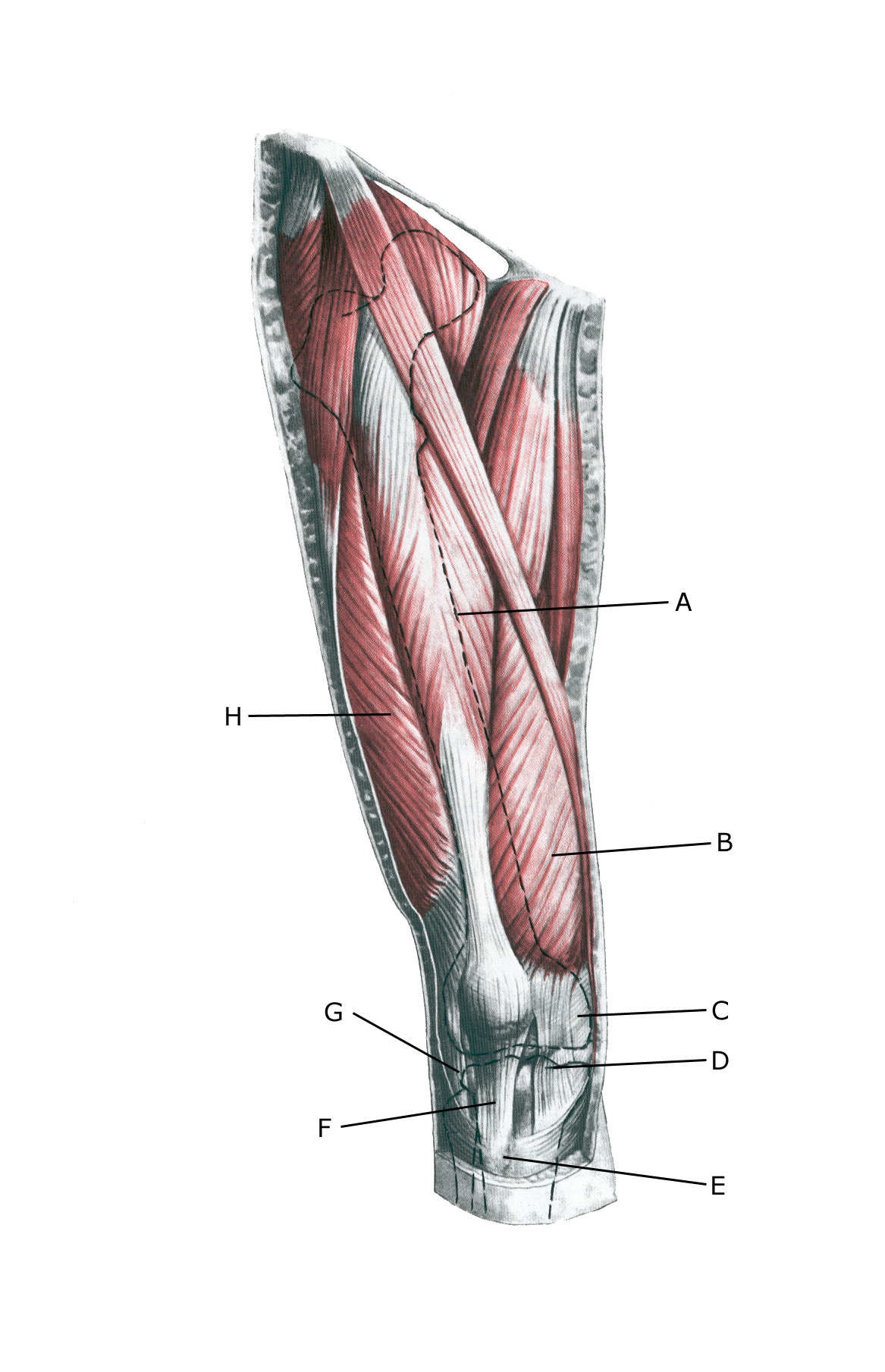Anatomy
The large anterior thigh muscle (musculus quadriceps femoris) consists of four muscles (m vastus lateralis, m vastus medialis, m vastus intermedius and m rectus femoris). The muscles all attach to the top edge of the kneecap. The patella tendon (ligamentum patellae) connects the lower edge of the patella to the upper, anterior part of the tibia (tuberositas tibiae).
The function of the patellar tendon is to transmit the force exerted by the large anterior thigh muscle when the knee is extended. Where the patellar tendon attaches to the patella and tibia, in adolescents there is a growth zone (apophysis).
 Knee from the front:
Knee from the front:
A. M. rectus femoris
B. M. vastus medialis
C. Retinaculum patellae mediale
D. Retinaculum patellae mediale
E. Tuberositas tibiae
F. Lig. Patellae
G. Retinaculum patellae laterale
H. M. vastus lateralis
Cause
Repeated repetitive loading of the patellar tendon (jumping, kicking) causes an overload-induced inflammation (‘inflammation’) at the attachment of the patellar tendon to the growth zone (apophysis) at the top front of the tibia (tuberositas tibiae, Osgood-Schlatter disease). The injury is caused when the load exceeds what the growth zone can withstand. In 20-30%, the injury is bilateral.
Training load should be reduced during periods of rapid growth (measure the height of young athletes every 3 months). Training should generally be varied and avoid repetitive movements. Alternate between different exercises over time to reduce strain. Quality of training is more important than quantity.
Symptoms
Slow-onset tenderness at the patellar tendon attachment on the front of the tibia (tuberositas tibiae) during and after sports activity. If the patellar tendon attachment on the tibia has been bothering you for a long time, the bone attachment can become so prominent that it is a nuisance when kneeling.
Especially young people between the ages of 9-15 experience symptoms, and Osgood-Schlatter disease is so common that it is seen in almost every youth football team. Symptoms fade at the latest when the growth zone closes around the age of 17.
In some (few) cases, symptoms may persist beyond the teenage years if the changes in the growth zone are significant, e.g. if there is severe prominence of the tibial prominence or loose bone islands in the tendon that may cause strain-related tendon problems in adulthood.
Examination
Usually, the diagnosis can be made by general clinical examination with the detection of localised pressure tenderness on the patellar tendon attachment on the tibia. If there is any doubt about the diagnosis, the changes are best detected with ultrasound scanning
Ultrasound scan of the patella attachment on the tibia (growth zone, Tuberositas Tibia) in a young athlete with Osgood-Schlatter. It can be seen that the bone at the Tuberositas Tibia is irregular (fragmented) and that there is increased blood vessel ingrowth in the area illustrated by the colours (Doppler activity). The tendon often becomes thickened and inhomogeneous (hypoeccotic).
Treatment
Treatment primarily includes relief from pain-inducing activity (jumping, kicking) and stretching of the anterior thigh muscle (Corbi F, et al. 2022). If treatment is started quickly, in some cases the injury can heal in a matter of weeks. It is therefore crucial to respond to the first symptoms to avoid prolonged periods of injury. If the pain has been present for several months before responding, the relief period can be very long (half to full years).
It will usually be sufficient to refrain from the most strenuous exercises (jumping) during the relief period, while many other training exercises can be completed without discomfort. In the vast majority of cases, it will therefore still be possible to participate in parts of the sports activity together with friends.
As with all overuse injuries to the growth zones, vigorous strength training of the injured tendon attachment is generally not indicated, as the growth zone cannot be trained stronger. Gentle activity that prevents muscle wasting (atrophy) is recommended. Later, muscle training can be slowly escalated within the pain threshold (Rathleff MS, et al. 2020). Once the pain has subsided, sporting activity can be gently resumed. Relapses will often occur, after which relief should be resumed as soon as possible.
The ice treatment can be repeated every time tenderness is induced at the patellar tendon attachment during the rehabilitation process. Adrenal cortical hormone injections usually have no place in treatment. In general, there is little evidence for the effectiveness of various treatment recommendations (Midtiby SL, et al. 2018).
It is important that the athlete, parents and coach are informed, understand and respect the need for load management during the rehabilitation period in order to avoid long-term injuries that can last six months to a year (Longo UG. et al., 2016 ).
Bandage
Some people find that applying tape or a similar bandage around the shinbone just below the kneecap can alleviate the discomfort. See taping
Complications
The prognosis is very good (but can be long-lasting) and the injury usually does not cause any discomfort later in life.
If no progress is made, the following should be considered:
- Cartilage damage in the joint
- Anterior knee pain
- Meniscus lesion
- Sinding-Larsen as well as fractures and infections.
Tearing of the patellar tendon from its attachment to the tibia has only been described in very rare cases. The torn bone part (to which the patellar tendon attaches) can be screwed to the tibia in a simple operation with good results.
